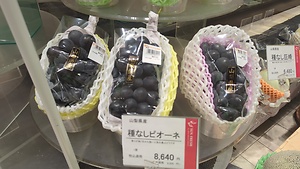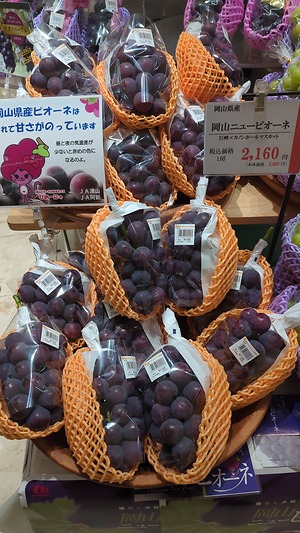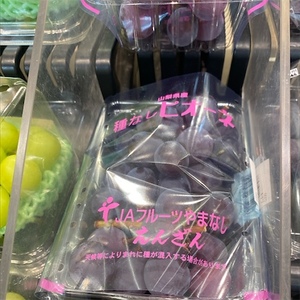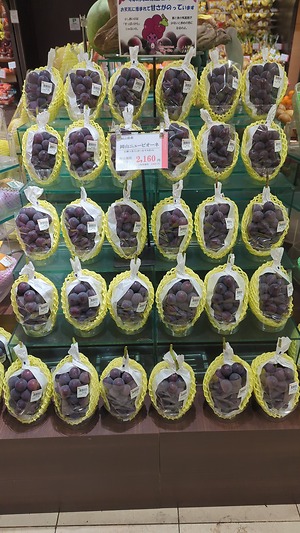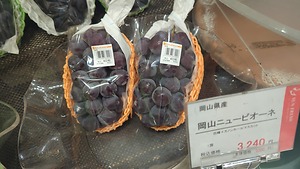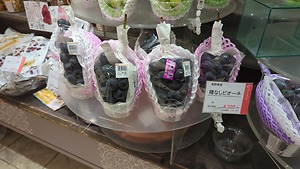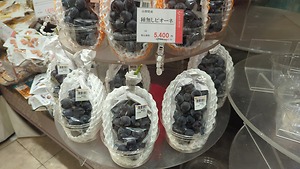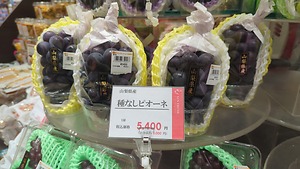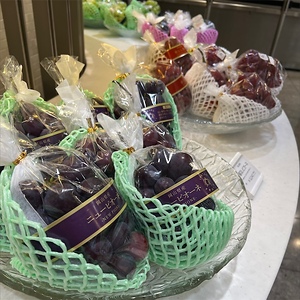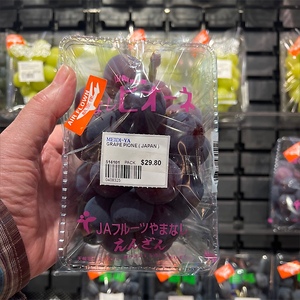


Pione Grapes
Estimated Inventory, lb : 0
Description/Taste
Pione grapes are a large varietal that grows in short, thick, and dense bunches. Each grape averages 2 to 5 centimeters in diameter and has a uniform and plump, round to oval shape. The grape’s skin is thick, smooth, and taut, appearing in shades of dark purple-red. The surface is also covered in a powdery blue-grey bloom, a protective coating that prevents disease and moisture loss. This bloom is edible and can be easily removed by wiping the fruits. Underneath the surface, the flesh is pale, translucent green, aqueous, and firm with a jelly-like consistency. The flesh may also contain a few small seeds or be found seedless, depending on cultivation practices. Pione grapes are aromatic and have high sugar content, ranging from 16 to 18 Brix. The grapes also contain moderate acidity, contributing to the flesh’s sweet-tart, sugary flavor with subtle fruity and wine-like undertones.
Seasons/Availability
Pione grapes are available in late spring through fall.
Current Facts
Pione grapes, botanically classified as part of the Vitis genus, are a hybrid variety belonging to the Vitaceae family. The sweet-tart grapes were created in Japan in the late 20th century and were selected for their large size, juicy nature, and dense flesh. Pione grapes were developed from the famous Japanese kyoho grape and have become the third most popular table grape in Japan, just behind delaware and kyoho grapes. The variety is known for its uniform appearance and extended storage capabilities, leading it to be a favored grape for staying fresh throughout dinner parties, pre-made desserts, picnics, and special occasions.
Nutritional Value
Pione grapes are a source of fiber to regulate the digestive tract, potassium to balance fluid levels within the body, and vitamin C to strengthen the immune system while reducing inflammation. The grapes also provide anthocyanins, colored pigments within the skin and flesh that have antioxidant-like properties to protect cells from the damage caused by free radicals and contain other nutrients, including vitamin K, copper, B vitamins, magnesium, and iron.
Applications
Pione grapes have a sweet and slightly tangy flavor well suited for fresh preparations. The large grapes can be consumed with or without their skin, depending on preference, but in Japan, they are traditionally chilled, peeled, and eaten straight, out of hand. Pione grapes are also blended into smoothies, sliced and tossed into green salads and fruit bowls, or displayed as a sweet element on charcuterie boards. In addition to appetizers, Pione grapes are sliced and layered into whipped cream sandwiches, used as a fresh topping over cakes, tarts, and parfaits, or simmered into jams or jellies. In Japan, Pione grapes are mainly consumed as a fresh snack, but the grapes are incorporated into mochi as a seasonal treat. Pione grapes are also pressed and fermented into a sweet wine or dried for extended use. Pione grapes pair well with cheeses such as blue, goat, parmesan, and brie, honey, herbs including rosemary, basil, and mint, leeks, and nuts such as almonds, hazelnuts, pecans, and walnuts. Whole, unwashed Pione grapes will keep up to one week when stored in a container or plastic bag in the refrigerator.
Ethnic/Cultural Info
Pione grapes were initially named Pioneer grapes in the 1950s when they were developed in Japan, but the variety’s name was later changed in 1973 to Pione, translating to mean “Pioneer” in Italian. Pione grapes are also known by several nicknames, including Black Pearl and Black Diamond, named for their pigmented, plump, and sweet nature. In Japan, there are two types of Pione grapes. The original Pione grape is seeded, but scientists eventually used a gibberellin treatment to create a seedless variety known as New Pione. Gibberellin is a natural hormone found in plants that promotes improved growth and seedless flesh. Regardless of the name or seed content, Pione grapes are among the most popular table grape varieties in Japan and are often sold in ornate packaging as a specialty fruit. Pione grapes can be found carefully packaged in soft foam netting and placed in a box decorated with tinsel, metallic printing, or bows. These ornate gifts are given to colleagues, business associates, and friends as a gesture of respect and courtesy.
Geography/History
Pione grapes were developed in Okayama, a prefecture on the island of Honshu in Southern Japan. The variety was created from a cross between kyoho grapes, a Japanese hybrid, and canon hall grapes, a large white table grape, and was bred by Japanese breeder Hideo Ikawa in 1957. Pione grapes were selected for their large size and sweet-tart flavor and were released in 1973 for commercial production. Today Pione grapes are grown in the Yamanashi, Okayama, Nagano, and Hiroshima Prefectures and are sold through distributors, local markets, and specialty grocers. The variety is also exported to other countries, including Australia, Singapore, and other regions of Southeast Asia.
Recipe Ideas
Recipes that include Pione Grapes. One
| Olive and Mango |
|
Roasted Grape Snack Cake |
| Jerje Kitchen |
|
Grape Wraps |
| Pip & Ebby |
|
Easy Peanut Butter Honey Wraps with Grapes and Cinnamon |



